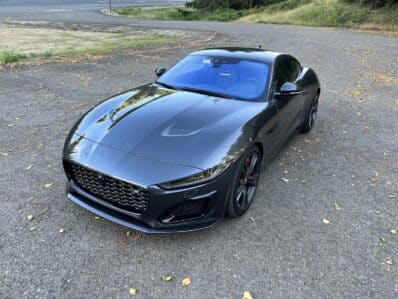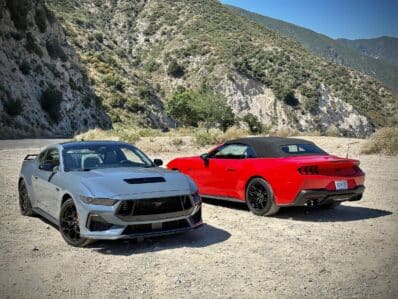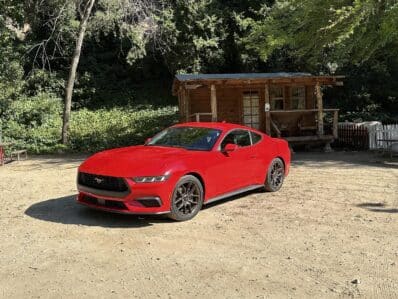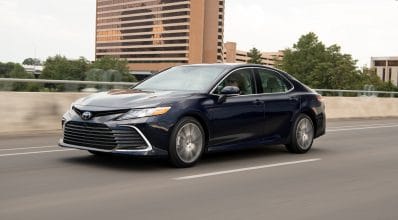
If there is any way to start an argument about a sports car, mention the 2021 Toyota GR Supra.
Its platform, powertrain and suspension were co-developed with BMW and used for its Z4 roadster. Toyota tweaked it all, adding its own settings, software and exterior styling. So, is it a Toyota? It’s a fair question. When the Supra started garnering a reputation in the early-to-mid 80s, Toyota had development help from Lotus and Yamaha. So, is this BMW relative really a Toyota Supra? Sure, it has an inline 6 and rear-wheel drive, but it’s built by Magna Steyr in Austria, not Japan, using BMW parts and switchgear.
And now that Toyota has released a less-expensive Supra powered by a 4-cylinder engine. In 1985, it would have been called a Celica, not a Supra. Way back when, 6-cylinder models were called Celica Supras, 4-cylinder models were called Celicas. So, assuming that you consider this BMW-derived Supra a Supra, is this 4-cylinder Supra really a Supra — or a Celica? But is it really a Toyota at all?

It’s an age-old question. Isn’t the Subaru-engineered 2016 Scion FR-S really a Subaru with a slight wardrobe adjustment? Is a 2011 Aston Martin Cygnet, in reality a Toyota iQ with a different badge and grille? Isn’t the 2005 Saab 9-2X, merely a modestly gussied-up Subaru Impreza? Isn’t the 1994 Honda Passport, a poorly-disguised Isuzu Rodeo? Or not?
Discuss among yourselves.
Overview
Despite being fairly new, the Supra gets some notable updates for 2021, including the addition of an entry-level 2.0 model in addition to the 3.0, 3.0 Premium and A91 trim levels offered last year. The new model gets a BMW-sourced 2.0-liter turbocharged four-cylinder engine. Other Supras get a BMW-sourced twin-turbocharged 3.0-liter inline-6, that gets a 14% bump in horsepower to 382 horsepower from 335 horses. Torque rises more modestly, up 3 to 368 pound-feet. Six-cylinder models also get a retuned chassis.

In addition, the Supra 2.0 uses smaller front brake rotors than the Supra 3.0, and with single-piston calipers vs. four-piston. It also lacks the 3.0’s Active Differential and Adaptive Suspension. The seats are manually adjustable, not power-adjustable as in other models, and wheels are 1-inch smaller, 18 inches, not 19.
Exterior
Beauty is in the eye of the beholder. From certain viewing angles, such as the side, or overhead rear three-quarters, the Supra seems fetchingly modern with classic sports car overtones. But from others, it’s — um — distinctive. OK, let’s be honest. It’s unrelentingly ugly, owing nothing to its past. The fake plastic vents that blemish the hood and the sides of the car are hokey. They are merely added cost that yield nothing in return. As long as function is following form, couldn’t the form look beautiful? Take a look back at previous Supras, particularly the previous one, and you’ll find that was always the case. Until now.
Interior

Being a sports car, you wouldn’t expect a spacious cabin, and you don’t get one. It’s extremely snug and storage space is skimpy. Ergonomically sound and fitted with BMW buttons and controls, its feel is decidedly downscale from the Z4’s cabin, although it is well-assembled.
The seats are well bolstered and comfortable, but narrow. If you’re broader of beam, try before you buy. Cargo space is adequate at a little over 10 cubic feet, enough to hold a couple duffle bags, or small suitcases.
Powertrain
Most Supras get a twin-turbocharged 3.0-liter inline-6-cylinder engine rated at 382 horsepower and 368 pound-feet of torque. The exception is the base 2.0 model, which is fitted with a 2.0-liter turbocharged four-cylinder engine that generates 255 horsepower and 295 pound-feet of torque. An 8-speed automatic transmission, and rear-wheel drive are standard on all models. Premium fuel is required.
Safety and Technology

Standard driver-assistance systems include a Pre-Collision System with Pedestrian Protection, Lane Departure Warning with Steering Assist, and Automatic High Beams. Tech goodies include a standard 8.8-inch display with rotary controller (far superior than nearly every other Toyota system) and a 4-speaker audio system. (A 10-speaker audio system is standard on other models.)
A $3,485 “Safety & Technology Package” adds Dynamic Radar Cruise Control, Blind Spot Monitor, Rear Cross-Traffic Alert, Parking Sensors with Emergency Braking, navigation system, 12-speaker 500-watt JBL audio system, wireless Apple CarPlay compatibility, and Supra Connected Services.
Given how difficult it is to safely see out of this car, consider this package essential, if only for the electronic safety nannies. It’s offered on available on the 2.0 and 3.0 models. A Driver’s Assist Package adds just the driver-assistance features, and is available on 3.0 Premium and A91 trim levels for $1,195. NHTSA has not crash-tested the 2021 Toyota GR Supra 2.0.
Driving impressions

If there’s any arguing with semantics or aesthetics, there aren’t any once you’re behind the wheel. With two fewer cylinders, and a range of other features that are not offered, this Supra weighs 219 pounds less than its more-powerful sibling.
But with fewer horses on tap, you’ll find its less tail-happy, a trait some drivers may not like. But there’s still plenty of power on tap. Reaching 60 mph takes less than five seconds. That’s not bad, but a second or so slower than its more powerful companion.
Still, there’s more than enough muscle to keep you entertained. And the quick steering, taut suspension, authoritative brakes, perfectly-weighted quick steering, and lack of body lean make this a treat and a trick. Bravo.
2021 Toyota GR Supra 2.0 specifications:
| Dimension | L: 172.5 inches/W: 73 inches/H: 51.1 inches/Wheelbase: 97.2 inches |
| Weight | 3,181 pounds |
| Powertrain | 2.0-liter twin-scroll turbocharged 4-cylinder engine, 8-speed automatic transmission, and rear-wheel drive |
| Fuel Economy | 25 mpg city/32 mpg highway/28 mpg combined |
| Performance Specs | 255 horsepower and 295 pound-feet of torque |
| Price | Base price: $42,990; As tested: $48,040 including $995 destination and delivery charge |
| On-Sale Date | Available now |
Wrap Up
If you don’t mind giving up a second in sprint times, as well as $8,000 in base price, the Supra 2.0 makes for a fine, fun-to-drive, rear-wheel-drive sports car. If you can live with the aesthetics this newest Supra beings to the table, you’ll be treated to a truly fun time. As for what it’s called, you’ll call it a good time. That said, some of the biggest party animals are always the homeliest.
2021 Toyota GR Supra 2.0 — Frequently Asked Questions
Why did Toyota make a 4-cylinder Supra?
Price. The 4-cylinder Supra costs $8,000 less than the least expensive 6-cylinder model, making it affordable for more buyers.
Is the 2021 Supra a Twin Turbo?
The 3.0-liter 6-cylinder engine is a twin-turbo engine; the 2.0-liter 4-cylinder engine used in the 2.0 model is not.
Who makes Toyota Supra’s 2.0 engine?
BMW. It’s the same B48B20 2.0-liter turbocharged inline-4 you’ll find under the hood of the Z4 sDrive30i, as well as a plethora of BMWs and the Mini Cooper.











